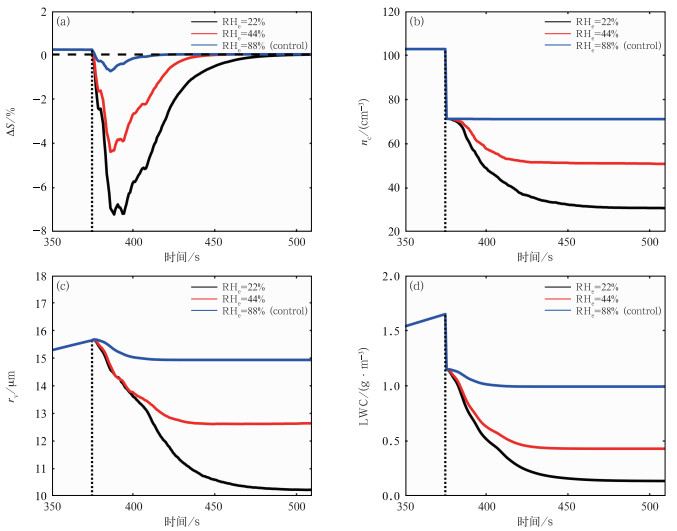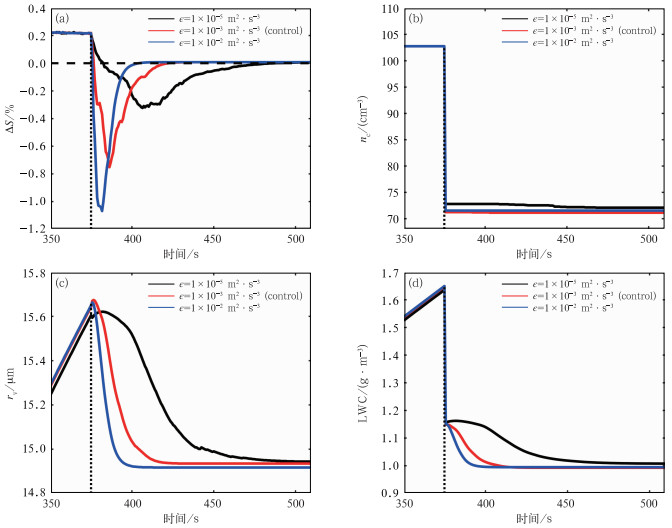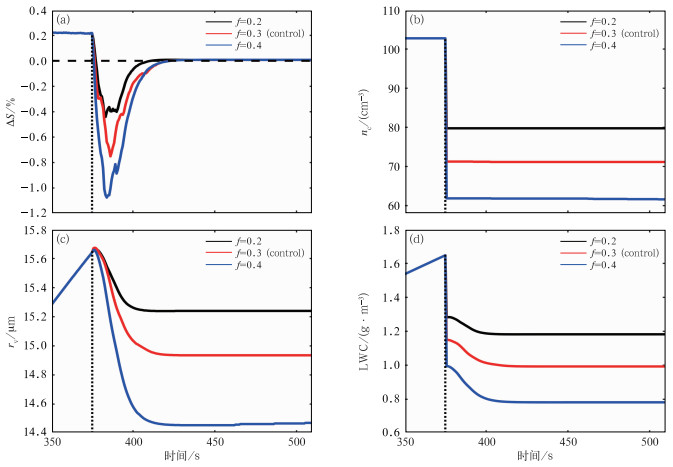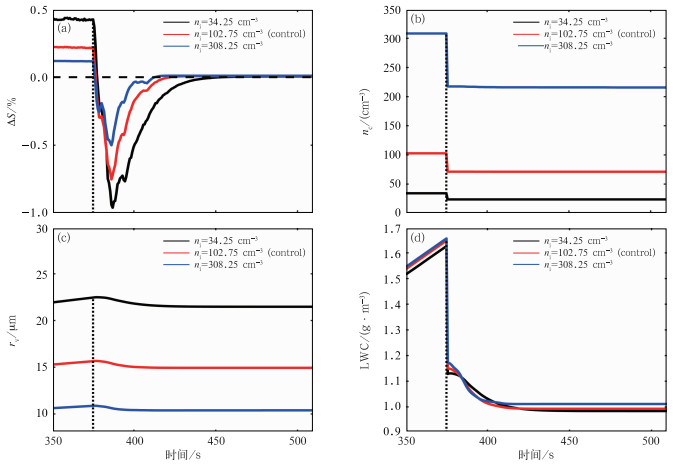2. 中国民用航空飞行学院航空气象学院,四川广汉 618307
2. College of Aviation Meteorology, Civil Aviation Flight University of China, Sichuan, Guanghan 618307
云是地球系统的重要组成部分,它显著地影响着地球系统的能量平衡(解小宁等,2016;吕巧谊等,2017;朱泽恩等,2017;Zhang et al, 2018;Lin, 2019;刘涛等,2015)、降水分布(Bai et al, 2018;Hou et al, 2020)以及天气、气候的变化(符传博等,2019;Ge et al, 2019;Yang and Gao, 2020)。云的宏微观物理特性对云的光学厚度(石广玉等,2008;Xie and Liu, 2013)、气溶胶间接效应的评估(解小宁等,2015;Li J M et al, 2018;Xie et al, 2018;陆春松等,2021;蔡兆鑫等,2021;Wang et al, 2021)乃至降水的生成具有重要作用(杨薇等,2017;Li et al, 2017;贾星灿等,2018;李筱杨等,2019;刘涛等,2015)。然而,目前的暖云降水形成理论并不能很好地解释实际观测结果(Johnson, 1993;Seifert and Onishi, 2016;Lu et al, 2018a;Li et al, 2020)。首先,观测结果表明,在自然界中暖云可以在15~30 min内形成降水(Stephens and Haynes, 2007;Beard and Ochs Ⅲ, 1993),这远小于暖云降水形成理论所需的时间(数十小时)。其次,绝热理论表明云滴半径的增长率和半径成反比,即小云滴半径增长的速率大于大云滴(Korolev and Isaac, 2000;邓玮等,2019)。因此,在绝热凝结过程中,云滴的尺度会逐渐接近,并在大云滴端形成云滴谱较窄的单峰分布(Warner, 1969;Wang et al, 2020b),导致云滴之间难以发生碰并过程进而形成降水。在实际观测结果中,云滴谱通常较宽并呈现为双峰或多峰分布,有利于云滴之间发生碰并(Sun et al, 2012;Chen et al, 2016;Li X Y et al, 2018;杨文霞等,2019;陆春松和徐晓齐,2021;Yin et al, 2022;周黎明等,2014)。然而,云滴谱如何从理论中的窄谱拓宽为实际观测中的宽谱,到目前还没有统一的结论。Lasher-Trapp et al(2005)、Devenish et al(2012)、Cooper et al(2013)、Lu et al(2013b;2018a)和朱磊等(2020)提出云和周围干空气之间的湍流夹卷混合过程可能是导致云滴谱拓宽的一个关键的因素,但是夹卷混合过程对云滴谱和云微物理量的影响尚不明确。
云内过饱和度是决定云滴凝结/蒸发的重要物理量,能够显著影响云滴谱和云微物理量(Morrison and Grabowski, 2008;Hudson et al, 2010;刘瑞翔等,2020;Xu et al, 2022)。夹卷混合过程通过影响云内过饱和度,使得云滴能够经历不同的过饱和度,进而导致云滴谱和云微物理量发生变化(Grabowski and Abade, 2017;Yang et al, 2018;Li et al, 2019;Chandrakar et al, 2021)。Lasher-Trapp et al(2005)发现夹卷混合过程引起的过饱和度波动,能够导致云滴谱向大滴方向拓宽。Tölle and Krueger(2014)指出当夹卷混合过程较慢时,云滴能够长时间处于不饱和状态,并经历更多变的过饱和环境。此外,夹卷混合过程受到卷入干空气相对湿度、湍流动能耗散率、卷入干空气在云中所占比例以及云滴数浓度等因子的影响。卷入干空气相对湿度越小时,过饱和度减小幅度越大(Pinsky et al, 2016),云滴蒸发越强,混合完成后云微物理量的值越小(罗仕等,2017)。卷入干空气相对湿度和湍流动能耗散率越大时,云滴越容易发生部分蒸发,导致云滴数浓度不变(Burnet and Brenguier, 2007;Luo et al, 2020),过饱和度能快速减小至最小值(Tölle and Krueger, 2014)。湍流动能耗散率越小时,干空气和云内空气混合的速率越慢,过饱和度能够在混合过程中长时间起伏,导致部分云滴长时间处于未饱和环境并发生完全蒸发(Tölle and Krueger, 2014)。卷入干空气比例越大时,云滴蒸发越显著(Lu et al, 2013a)。Chen et al(2020)的研究结果也表明随着夹卷率的增大,进入云内的干空气增加,过饱和度的最小值减小。云滴数浓度越大时,云滴对水汽的竞争越强,云内过饱和度越小,导致云滴尺度越小(Kudzotsa et al, 2016;Jia H L et al, 2019),越容易发生完全蒸发(Kumar et al, 2013)。尽管学者们在夹卷混合过程的研究中涉及过饱和度以及夹卷相关因子的分析,但是并未清晰地揭示过饱和度在夹卷混合过程中的演变以及相关因子的影响,因此目前夹卷混合过程对过饱和度影响的认识还很有限,需要进一步深入研究。
针对以上问题,本文利用高分辨率的显式混合气泡模式(Krueger et al, 1997;Su et al, 1998;Tölle and Krueger, 2014),分析云内过饱和度在夹卷混合过程中的演变,研究过饱和度在卷入干空气相对湿度、湍流动能耗散率、卷入干空气比例以及云滴数浓度影响下的特征,为更加深入地理解夹卷混合过程和暖云降水理论提供支撑。
1 模式及参数设置显式混合气泡模式(EMPM)是Krueger et al(1997)在线性涡度模式(Kerstein, 1988; 1992)的基础上,为了研究云和周围干空气之间的夹卷混合过程而专门开发的高分辨率数值模式。该模式通过将无云内部结构的传统气泡模式和能够解析云尺度上云内部结构变化的多维云模式相结合,实现了在毫米尺度上呈现云内部结构的变化。在EMPM中,云内部结构的变化是由夹卷过程和湍流混合过程产生。EMPM设定模拟区域内气块的物理性质在统计上是均匀的(Austin et al, 1985),在夹卷过程中,干空气在进入气块之前,模拟区域中与干空气块尺度相同的区域被移除,随后卷入的干空气进行补充,但干空气块卷入模拟区域后不会影响气块的统计属性(Krueger et al, 1997;Tölle and Krueger, 2014)。干空气进入气块的速率由夹卷率(λ)决定,其定义为云在抬升过程中云质量随高度的变化率与云质量的比值(Su et al, 1998)。表达式如下:
| $ \lambda=\frac{1}{m} \frac{\mathrm{d} m}{\mathrm{~d} z} $ | (1) |
式中:m是气块的质量,z是高度。
在湍流混合过程中,在湍流的作用下卷入的干空气会发生形变、破碎,增加卷入干空气和云内空气的接触面积以及水汽、温度等标量场的梯度。当干空气尺度减小至柯尔莫戈洛夫微尺度(约为毫米量级)时,分子扩散过程起作用,并能迅速使标量场梯度减小并变得均匀。分子扩散方程如下:
| $ \frac{\partial \phi}{\partial t}=D_{\mathrm{M}} \frac{\partial^2 \phi}{\partial x^2} $ | (2) |
式中:t是时间,ϕ是水汽、温度等标量,DM是分子扩散系数。此外,在夹卷混合过程中EMPM能够根据云滴周围环境(温度、水汽混合比和气压)的变化,追踪每个云滴的凝结/蒸发情况。液滴的蒸发/凝结方程为(Fukuta and Walter, 1970):
| $ r_j \frac{\mathrm{d} r_j}{\mathrm{~d} t}=\frac{S-A_1+A_2}{A_3+A_4} $ | (3a) |
| $ S=\frac{q_{\mathrm{v}}}{q_{\mathrm{vs}}}-1 $ | (3b) |
式中:rj是第j个云滴的半径;A1和A2分别是液滴曲率效应和溶质效应的修正因子,A3和A4分别是热传导和水汽扩散项;S是过饱和度;qv是水汽混合比;qvs是饱和水汽混合比。
在EMPM中,饱和的气块以一定速度从云底绝热抬升,云滴凝结增长。当气块抬升到夹卷过程发生高度时,停止抬升,云外干空气通过夹卷进入云内,并随机卷出与干空气尺度相当的云内空气。紧接着,云内空气和干空气之间进行等压混合过程。在湍流的作用下干空气块会破碎成许多尺度更小的干空气块,并随机分布在云内,改变云内温度场和水汽场,使得云滴因周围过饱和度的变化而发生凝结/蒸发过程(Krueger et al, 2008)。凭借EMPM的优势,该模式成功再现了夏威夷积云观测结果中的云滴谱(Su et al, 1998),并随后被用于夹卷混合过程对云微物理量影响的研究(Tölle and Krueger, 2014;Lu et al, 2018b;Luo et al, 2020)、夹卷混合机制的识别(Lu et al, 2014;Luo et al, 2021)以及夹卷混合机制参数化方案的开发(Lu et al, 2013a;Luo et al, 2020)。
与Tölle and Krueger(2014)研究一致,在本研究中EMPM的模拟区域为20 m(长)× 0.001 m(宽)× 0.001 m(高),并以2 m·s-1垂直速度从云底绝热抬升。经过375.75 s后,到达夹卷发生高度,此时垂直速度变为0 m·s-1。尺度为2 m×0.001 m×0.001 m的干空气块通过夹卷进入云内,并与云内空气进行等压混合。模式中云底信息来自夏威夷积云观测项目(Raga et al, 1990),云底温度、气压和水汽混合比分别为293.95 K、963.95 hPa、15.73 g·kg-1。在夹卷混合过程中,卷入干空气相对湿度(RHe)和卷入干空气比例(f)通过改变卷入干空气的性质来影响过饱和度(Chen et al, 2020;Pinsky et al, 2016),湍流动能耗散率(ε)通过改变夹卷过程混合速率来影响过饱和度(Tölle and Krueger, 2014;Andrejczuk et al, 2006),初始云滴数浓度(ni)通过影响云滴蒸发速率来影响过饱和度(Kumar et al, 2013)。浅积云的大涡模拟和观测结果显示,RHe可以在70%~95%(Burnet and Brenguier, 2007);ε可以在10-5~10-2 m2·s-3(Siebert et al, 2006);ni可以在20 ~ 700 cm-3(Burnet and Brenguier, 2007;Hudson et al, 2012)。根据以上结果以及参考Tölle and Krueger(2014)和Lu et al(2013a)中EMPM模式参数的设置,在对照试验中RHe,ε,f,ni分别设置为88%、1×10-3 m2·s-3、0.3、102.75 cm-3。为了研究以上各因子的影响,在敏感性试验中,RHe分别设置为88%、44%、22%,可以表示紧邻云和远离云的干空气湿度的影响。ε分别设置为1×10-2、1×10-3、1×10-5 m2·s-3,可以表示干空气和云内空气混合速率的影响。f分别设置为0.2、0.3、0.4,可以表示卷入云内干空气总量的影响。本研究使用和Krueger et al(1997)、Su et al(1998)、Lu et al(2013a)、Tölle and Krueger(2014)相同的云凝结核(CCN)来驱动EMPM模式,CCN凝结形成的云滴个数为2055个,对应的数浓度为102.75 cm-3。为了研究云滴数浓度对结果的影响,ni分别取102.75 cm-3的1/3、1、3倍进行敏感性试验,即34.25、102.75、308.25 cm-3。以上参数如表 1所示。
|
|
表 1 显式混合气泡模式(EMPM)中的参数设置 Table 1 Parameters in the Explicit Mixing Parcel Model (EMPM) |
云滴周围过饱和度的变化直接影响云滴的凝结/蒸发过程,因此本文围绕夹卷混合过程对云滴周围过饱和度的影响进行研究。图 1显示当RHe= 88%,ε=1×10-3 m2·s-3,f=0.3,ni=102.75 cm-3时,在绝热云和包含夹卷混合过程的云中,云滴周围过饱和度(ΔS=RH-100%,其中RH为相对湿度)、云滴数浓度(nc)、体积平均半径(rv)以及含水量(LWC)在夹卷混合过程中的演变。在绝热条件下,ΔS随时间先增加后减小,并在ΔS=1.1%处出现峰值(图 1a)。当气块绝热抬升冷却供应水汽的速率大于云滴凝结消耗水汽的速率时,ΔS随时间逐渐增大;当云滴凝结消耗水汽的速率大于抬升冷却供应水汽的速率时,ΔS随时间逐渐减小;当水汽消耗的速率和水汽供应的速率相等时,ΔS出现最大值,该结果和绝热理论一致(Morrison and Grabowski, 2008;杨军等,2011;Sun et al, 2012;Pinsky and Khain, 2020)。在此过程中,nc保持不变(图 1b),rv和LWC逐渐增大(图 1c,1d)。在375.75 s后垂直速度变为0 m·s-1,云不再抬升,ΔS,nc,rv,LWC保持不变。

|
图 1 绝热云和包含夹卷混合过程的云中(a)云滴周围过饱和度、(b)云滴数浓度、(c)体积平均半径、(d)含水量的变化 图 1a中虚线表示饱和线,ΔS=0;点线: 夹卷混合过程开始时间。 Fig. 1 The evolutions of (a) supersaturation of droplets, (b) cloud droplet number concentration, (c) volume-mean radius, and (d) liquid water content in the adiabatic cloud and the cloud considering entrainment-mixing process |
考虑夹卷混合过程后(对照试验),ΔS在夹卷混合过程中先减小后增大。夹卷开始时(375.75 s),不饱和的云外干空气通过夹卷过程进入云内。由于不饱和干空气的稀释作用,导致ΔS显著减小(Tölle and Krueger, 2014),并在386.25 s时出现最小值(-0.7%,图 1a)。夹卷混合过程刚开始阶段,卷入干空气会在湍流的作用下逐渐发生形变、破碎。随着混合过程的进行,与破碎的干空气块相接触的云滴增多,ΔS逐渐减小。此时,虽然云滴会发生蒸发,促进卷入干空气的相对湿度增大,但是不断破碎的干空气块对ΔS的减小作用大于云滴蒸发对ΔS的补充作用(Kumar et al, 2017)。当两者对ΔS的影响相当时,ΔS达到最小值。此时,nc因干空气的稀释作用和云滴的完全蒸发显著减小(Lehmann et al, 2009),数值从绝热时的102.75 cm-3减小至71.25 cm-3(图 1b)。rv从15.67 μm减小至15.42 μm(图 1c),LWC从稀释后的1.15 g·m-3,因云滴的蒸发减小至1.09 g·m-3(图 1d)。在随后的混合过程中,由于云滴的进一步蒸发对ΔS的补充作用占主导,ΔS逐渐增大,nc,rv,LWC逐渐减小,直到422.25 s时干空气达到饱和(ΔS=0),云滴不再蒸发,ΔS,nc,rv,LWC保持不变。
2.2 敏感性试验 2.2.1 卷入干空气相对湿度的影响为了研究RHe对ΔS的影响,在对照试验设置的基础上,RHe分别设置为88%(对照)、44%、22%。图 2显示了RHe的影响下,ε=1×10-3 m2· s-3,f=0.3,ni=102.75 cm-3时,ΔS,nc,rv,LWC在夹卷混合过程的演变。夹卷发生前,ΔS的值为0.4%。夹卷后,ΔS在三个RHe下都显著减小,并分别在386.25、389.25、394.5 s达到最小值,数值为-0.7%、-4.1%、-7.2%。在随后的混合过程中,干空气分别在422.25、459.75、514.5 s达到饱和(图 2a)。RHe越小,ΔS减小的幅度越大,数值越小,并且恢复饱和状态所需的时间越长。和对照试验相比(RHe=88%),当RHe=44%、22%时,nc,rv,LWC大幅减小。nc分别从71.3 cm-3减小至51.2、30.4 cm-3(图 2b),rv分别减小至12.63、10.28 μm(图 2c),LWC分别减小至0.43、0.14 g·m-3(图 2d)。当RHe越小时,卷入干空气对ΔS的影响越大(Pinsky et al, 2016),需要云滴大量蒸发来补充水汽,云滴通常需要发生完全蒸发使干空气达到饱和。因此,nc,rv,LWC在混合过程中显著减小,并且恢复饱和的时间显著增长(Devenish et al, 2012;Slawinska et al, 2012;罗仕等,2017)。

|
图 2 卷入干空气相对湿度(RHe)的影响下(a)云滴周围过饱和度、(b)云滴数浓度、(c)体积平均半径、(d)含水量的变化 图 2a中虚线表示饱和线,ΔS=0;点线: 夹卷混合过程开始时间。 Fig. 2 The evolutions of (a) supersaturation of droplets, (b) cloud droplet number concentration, (c) volume-mean radius, and (d) liquid water content under the effects of entrained dry air relative humidity (RHe) |
当ε=1×10-5、1×10-3(对照)、1×10-2 m2·s-3时,图 3显示了当RHe=88%、f=0.3、ni=102.75 cm-3时,ε对ΔS,nc,rv、LWC的影响。当ε从1×10-5 m2·s-3增大到1×10-2 m2·s-3时,湍流强度增强,ΔS分别在410.25、386.25、381.75 s减小至-0.31%、-0.75%、-1.1%(图 3a)。在随后的混合过程中,干空气分别在487.5、422.25、404.25 s时达到饱和。ε越大,ΔS减小的幅度越大,越迅速,恢复饱和所需的时间越短,该结果和Andrejczuk et al(2006)一致。当ε较大时,卷入干空气块和云内空气之间混合快,卷入干空气块在湍流的作用下破碎得快,使得在短时间内有更多的云滴和干空气接触,导致ΔS大幅度的迅速减小。当ε较小时,干空气和云内空气之间混合慢,部分云滴能够长时间和干空气接触蒸发,增加干空气的相对湿度(Jensen and Baker, 1989;Andrejczuk et al, 2004),导致ΔS小幅度减小,并且使恢复饱和所需的时间变长。因此,随着ε的增大,nc,rv,LWC能够快速减小。在夹卷混合过程完成后,不同ε下,nc,rv,LWC值的差异较小(图 3b, 3c, 3d)。

|
图 3 湍流动能耗散率(ε)的影响下(a)云滴周围过饱和度、(b)云滴数浓度、(c)体积平均半径、(d)含水量的变化 图 3a中虚线表示饱和线,ΔS=0;点线: 夹卷混合过程开始时间。 Fig. 3 The evolutions of (a) supersaturation of droplets, (b) cloud droplet number concentration, (c) volume-mean radius, and (d) liquid water content under the effects of turbulent kinetic energy dissipation rate (ε) |
图 4显示了当RHe=88%、ε=1×10-3 m2·s-3、ni=102.75 cm-3,f=0.2、0.3(对照)、0.4时,ΔS,nc,rv,LWC在夹卷混合过程中的演变。当f从0.2增大到0.4时,ΔS分别在383.25、386.25、384 s减小至最小值,数值为-0.4%、-0.7%、-1.1% (图 4a)。随着f的增大,进入云内的干空气增多,导致干空气在云中的占比增大,受干空气影响的云滴增多,ΔS减小的幅度增大,该结果和Chen et al(2020)的结果一致。Chen et al(2020)的研究结果表明随着夹卷率的增大,进入云内的干空气增加,ΔS的最小值减小。在随后的混合过程中,f增大,云内空气恢复饱和的时间增长,分别为411、422.25、423.75 s。当f分别为0.2、0.3、0.4时,在夹卷混合过程完成后,nc从102.75 cm-3减小至79.8、71.3、61.6 cm-3(图 4b),rv从15.64 μm减小至15.24、14.94、14.45 μm(图 4c),LWC从1.28、1.15、0.99 g·m-3减小至1.18、0.99、0.78 g·m-3(图 4d)。f越大,干空气的稀释作用越强,为了使云内空气恢复饱和状态,云滴的蒸发量越大(Jensen and Baker, 1989;Lu et al, 2013a)。

|
图 4 卷入干空气比例(f)的影响下(a)云滴周围过饱和度、(b)云滴数浓度、(c)体积平均半径、(d)含水量的变化 图 4a中虚线表示饱和线,ΔS=0;点线: 夹卷混合过程开始时间。 Fig. 4 The evolutions of (a) supersaturation of droplets, (b) cloud droplet number concentration, (c) volume-mean radius, and (d) liquid water content under the effects of entrained environment air fraction (f) |
当ni=34.25、102.75(对照)、308.25 cm-3时,图 5显示了RHe=88%、ε=1×10-3 m2·s-3、f=0.3的条件下,ni在夹卷混合过程中对ΔS,nc,rv、LWC的影响。在夹卷前,当ni=34.25、102.75、308.25 cm-3时,ΔS分别为0.42%、0.22%、0.12%(图 5a),对应的rv分别为22.49、15.67、10.88 μm(图 5c)。因为ni越小,云滴对水汽的竞争越小,云中剩余水汽的量越大,所以夹卷前ΔS和rv越大(Yum and Hudson, 2005;杨军等,2011;Xie et al, 2018;Yang et al, 2018;Zhao et al, 2018;Wang et al, 2020a)。夹卷后,ΔS在387.75、386.25、385.5 s减小至-0.9%、-0.7%、-0.5%。ni越大,ΔS减幅越小。在随后的过程中,云内空气分别在454.5、422.25、413.25 s时恢复饱和状态(图 5a),对应的nc分别减小至23.75、71.25、217.45 cm-3(图 5b),rv分别减小至21.48、14.93、10.39 μm(图 5c)。在不同ni的条件下,LWC的差异较小(图 5d)。ni越大,云滴尺度越小(Wang et al, 2020b),蒸发越快(Hill et al, 2009),恢复饱和状态所需的时间越短。在夹卷过程中稀释和发生完全蒸发的云滴数量越多,因此nc减小的幅度越大。此外,因为ni较大时云滴能够快速蒸发补充干空气的湿度,所以虽然在发生夹卷前ΔS小,但是ΔS减小的幅度小,最终ΔS最小值能够大于ni较小的情况。

|
图 5 初始云滴数浓度(ni)的影响下(a)云滴周围过饱和度、(b)云滴数浓度、(c)体积平均半径、(d)含水量的变化 图 5a中虚线表示饱和线,ΔS=0;点线: 夹卷混合过程开始时间。 Fig. 5 The evolutions of (a) supersaturation of droplets, (b) cloud droplet number concentration, (c) volume-mean radius, and (d) liquid water content under the effects of initial cloud droplet number concentration (ni) |
本文利用高分辨率的显式混合气泡模式(EMPM),研究了夹卷混合过程中云滴周围过饱和度的演变特征;分析了不同影响因子在夹卷混合过程中对云滴周围过饱和度的影响,得到如下结论。
在夹卷混合过程中,云滴周围过饱和度先减小后增大,直到气块恢复饱和。在夹卷混合过程开始阶段,随着破碎的干空气块增多,受干空气块影响的云滴增多。此时,干空气块对过饱和度的减小作用大于云滴蒸发的补充作用,导致过饱和度逐渐减小。当两者对过饱和度的影响相当时,过饱和度达到最小值。在随后的混合过程中,云滴蒸发对过饱和度的补充作用占主导,导致过饱和度逐渐增大。云滴数浓度、体积平均半径、含水量因干空气的稀释作用和云滴的蒸发显著减小。在夹卷混合过程完成后云滴不再蒸发,云微物理量保持不变。
由于夹卷受到多个因子的制约,本文分别探讨了各个因子对云滴周围过饱和度的影响。首先,卷入干空气相对湿度较大时,干空气达到饱和需要云滴的蒸发量小,过饱和度减小的幅度小,云内空气恢复饱和状态需要的时间短;数浓度、体积平均半径、含水量在夹卷混合过程中的减幅小。其次,湍流动能耗散率较小时,干空气和云内空气之间的混合速率小,部分云滴能够长时间和干空气接触蒸发,增大干空气相对湿度,导致过饱和度减幅度变小,云内空气恢复饱和状态的所需时间长;但在夹卷混合过程完成后数浓度、体积平均半径、含水量的差异较小。再次,卷入干空气在云中比例较大时,进入云内的干空气多,云滴的蒸发量大,导致受干空气影响的云滴增多,过饱和度显著减小,云内空气恢复饱和需要的时间长;数浓度、体积平均半径、含水量显著减小。最后,初始云滴数浓度较大时,云滴尺度小,蒸发快,云滴能够快速蒸发补充干空气的湿度,导致云内空气恢复饱和状态所需要的时间短,云滴数浓度因稀释和蒸发显著减小。
过饱和度是直接影响云滴生长情况的重要物理量之一。明确夹卷混合过程对过饱和度的影响对理解云微物理量在该过程中的演变至关重要。但在以往的研究中并未清晰指出过饱和度在夹卷混合过程中的演变以及夹卷相关因子对过饱和度演变的影响(Pinsky et al, 2016;Tölle and Krueger, 2014;Chen et al, 2020)。本研究揭示了夹卷混合过程对过饱和度的影响,并清晰给出了热力、动力、微物理因子对过饱和度的减小幅度和恢复饱和时间的作用机理,弥补了以往研究的不足,提升了对夹卷混合过程的理解。此外,夹卷混合过程对过饱和度的影响会进一步影响气溶胶的活化,导致云滴数浓度、云滴尺度等微物理量发生变化(李义宇等,2022;Jia X C et al, 2019;石茹琳等,2021;沙桐等,2019),进而改变云的反照率和生命周期(杨怡曼等,2020;Qiu et al, 2017)。在本研究中夹卷混合过程对过饱和度产生影响后,并没有进一步考虑气溶胶活化的影响。经历夹卷混合过程后,过饱和度的减小会抑制气溶胶的活化,不利于云滴的形成,导致云滴谱和云微物理量发生变化。因此,在以后的工作中需要进一步研究夹卷混合过程对气溶胶活化的影响。
蔡兆鑫, 蔡淼, 李培仁, 等, 2021. 华北地区一次气溶胶与浅积云微物理特性的飞机观测研究[J]. 大气科学, 45(2): 393-406. Cai Z X, Cai M, Li P R, et al, 2021. An in-situ case study on micro physical properties of aerosol and shallow cumulus clouds in North China[J]. Chin J Atmos Sci, 45(2): 393-406 (in Chinese).
|
邓玮, 孙继明, 雷恒池, 2019. 三参数云微物理方案中气溶胶谱函数对云滴谱影响的数值模拟研究[J]. 气候与环境研究, 24(6): 693-710. Deng W, Sun J M, Lei H C, 2019. Numerical simulation research on the effects of the size distribution of aerosols on the droplet spectrum with a newly developed Triple-Moment Bulk Scheme[J]. Climatic Environ Res, 24(6): 693-710 (in Chinese).
|
符传博, 丹利, 冯锦明, 等, 2019. 1960~2012年中国地区总云量时空变化及其与气温和水汽的关系[J]. 大气科学, 43(1): 87-98. Fu C B, Dan L, Feng J M, et al, 2019. Temporal and spatial variations of total cloud amount and their possible relationships with temperature and water vapor over China during 1960 to 2012[J]. Chin J Atmos Sci, 43(1): 87-98 (in Chinese).
|
贾星灿, 马新成, 毕凯, 等, 2018. 北京冬季降水粒子谱及其下落速度的分布特征[J]. 气象学报, 76(1): 148-159. Jia X C, Ma X C, Bi K, et al, 2018. Distributions of particle size and fall velocities of winter precipitation in Beijing[J]. Acta Meteor Sin, 76(1): 148-159 (in Chinese).
|
李筱杨, 郑佳锋, 朱克云, 等, 2019. 基于雷达资料的一次高原涡天气云降水宏微观特征研究[J]. 气象, 45(10): 1415-1425. Li X Y, Zheng J F, Zhu K Y, et al, 2019. Study of macro and micro properties of cloud and precipitation caused by Tibetan Plateau vortex based on radar observations[J]. Meteor Mon, 45(10): 1415-1425 (in Chinese). DOI:10.7519/j.issn.1000-0526.2019.10.008
|
李义宇, 郭学良, 金莲姬, 等, 2022. 华北中部夏季气溶胶垂直分布及其与云凝结核和云滴转化关系的飞机观测研究[J]. 大气科学, 46(4): 845-858. Li Y Y, Guo X L, Jin L J, et al, 2022. Aircraft measurements of summer vertical distributions of aerosols and transitions to cloud condensation nuclei and cloud droplets in central Northern China[J]. Chin J Atmos Sci, 46(4): 845-858 (in Chinese).
|
刘瑞翔, 刘端阳, 姚雷, 等, 2020. 近十年连云港市霾变化特征及其气象条件分析[J]. 气象, 46(7): 959-970. Liu R X, Liu R Y, Yao L, et al, 2020. Analysis on the variation characteristics and meteorological conditions of haze in Lianyungang City in recent decade[J]. Meteor Mon, 46(7): 959-970 (in Chinese).
|
刘涛, 孙晶, 周毓荃, 等, 2015. 一次低槽冷锋层状云系结构和过冷水分布特征的模拟研究[J]. 气象, 41(10): 1232-1244. Liu T, Sun J, Zhou Y Q, et al, 2015. Simulation study on stratiform cloud structure of trough cold front and characteristics of supercooled water distribution[J]. Meteor Mon, 41(10): 1232-1244 (in Chinese). DOI:10.7519/j.issn.1000-0526.2015.10.006
|
陆春松, 徐晓齐, 2021. 云中夹卷混合过程的研究进展[J]. 暴雨灾害, 40(3): 271-279. Lu C S, Xu X Q, 2021. Advances in the studies of cloud entrainment and mixing process[J]. Torr Rain Dis, 40(3): 271-279 (in Chinese). DOI:10.3969/j.issn.1004-9045.2021.03.005
|
陆春松, 薛宇琦, 朱磊, 等, 2021. 基于层积云飞机观测资料评估气溶胶间接效应[J]. 大气科学学报, 44(2): 279-289. Lu C S, Xue Y Q, Zhu L, et al, 2021. Evaluation of aerosol indirect effect based on aircraft observations of stratocumulus[J]. Trans Atmos Sci, 44(2): 279-289 (in Chinese).
|
罗仕, 陆春松, 郭小浩, 等, 2017. 夹卷混合过程对青藏高原云滴谱及微物理量影响的数值模拟研究[J]. 中国科技论文, 12(9): 972-977. Luo S, Lu C S, Guo X H, et al, 2017. Numerical simulation of the effects of entrainment-mixing on cloud droplet size distributions and microphysical properties over the Tibetan Plateau[J]. China Sciencepaper, 12(9): 972-977 (in Chinese). DOI:10.3969/j.issn.2095-2783.2017.09.002
|
吕巧谊, 张玉轩, 李积明, 2017. 南半球中高纬度区域不同类型云的辐射特性[J]. 气象学报, 75(4): 596-606. Lü Q Y, Zhang Y X, Li J M, 2017. Radiative characteristics of various cloud types over southern mid-high latitudes[J]. Acta Meteor Sin, 75(4): 596-606 (in Chinese).
|
沙桐, 马晓燕, 银燕, 等, 2019. 石家庄地区气溶胶和CCN垂直廓线的飞机观测分析[J]. 大气科学学报, 42(4): 521-530. Sha T, Ma X Y, Yin Y, et al, 2019. Aircraft measurements and analysis of the vertical distribution of aerosol particles and CCN over the Shijia- zhuang Area[J]. Trans Atmos Sci, 42(4): 521-530 (in Chinese).
|
石广玉, 王标, 张华, 等, 2008. 大气气溶胶的辐射与气候效应[J]. 大气科学, 32(4): 826-840. Shi G Y, Wang B, Zhang H, et al, 2008. The radiative and climatic effects of atmospheric aerosols[J]. Chin J Atmos Sci, 32(4): 826-840 (in Chinese). DOI:10.3878/j.issn.1006-9895.2008.04.11
|
石茹琳, 银燕, 陈倩, 等, 2021. 气溶胶对新疆冰雹形成物理过程影响的数值模拟研究[J]. 大气科学, 45(1): 107-122. Shi R L, Yin Y, Chen Q, et al, 2021. Numerical simulation of aerosol effects on the physical processes of hail formation in Xinjiang[J]. Chin J Atmos Sci, 45(1): 107-122 (in Chinese).
|
解小宁, 刘晓东, 王昭生, 2015. 云滴谱离散度对气溶胶间接效应影响的研究进展[J]. 地球环境学报, 6(2): 127-134. Xie X N, Liu X D, Wang Z S, 2015. Review of influence of cloud droplet spectral dispersion on aerosol indirect effects[J]. J Earth Environ, 6(2): 127-134 (in Chinese).
|
解小宁, 王昭生, 王红丽, 等, 2016. 云微物理特性及云滴有效半径参数化: 一次降水层状云的飞机观测资料结果[J]. 地球环境学报, 7(1): 12-18. Xie X N, Wang Z S, Wang H L, et al, 2016. Cloud microphysical properties and parameterization of cloud droplet effective radius from aircraft measurements: aircraft observational results from a stratiform precipitation cloud[J]. J Earth Environ, 7(1): 12-18 (in Chinese).
|
杨军, 陈宝君, 银燕, 等, 2011. 云降水物理学[M]. 北京: 气象出版社: 119-123. Yang J, Chen B J, Yin Y, et al, 2011. Physics of Clouds and Precipitation[M].
Beijing: China Meteorological Press: 119-123 (in Chinese).
|
杨薇, 冯文, 李勋, 2017. 微物理过程和积云参数化方案对海南岛秋季暴雨模拟的影响[J]. 暴雨灾害, 36(1): 8-17. Yang W, Feng W, Li X, 2017. Impacts of microphysical processes and cumulus parameterization schemes on simulated rainfall in autumn over the Hainan Island[J]. Torr Rain Dis, 36(1): 8-17 (in Chinese). DOI:10.3969/j.issn.1004-9045.2017.01.002
|
杨文霞, 范皓, 杨洋, 等, 2019. 一次层状云降雨过程多源遥感特征参量演变分析[J]. 气象, 45(9): 1278-1287. Yang W X, Fan H, Yang Y, et al, 2019. Evolution analysis of physical quantities obtained by multi-source remote sensing in a process of stratiform cloud rainfall[J]. Meteor Mon, 45(9): 1278-1287 (in Chinese).
|
杨怡曼, 周毓荃, 蔡兆鑫, 2020. 气溶胶垂直分布及活化特性的飞机观测个例研究[J]. 气象, 46(9): 1199-1209. Yang Y M, Zhou Y Q, Cai Z X, 2020. A case study of aircraft observation of aerosol vertical distribution and activation characteristics[J]. Meteor Mon, 46(9): 1199-1209 (in Chinese).
|
周黎明, 牛生杰, 王俊, 2014. 不同天气系统层状云微物理特征个例分析[J]. 气象, 40(3): 327-335. Zhou L M, Niu S J, Wang J, 2014. Case analysis on microphysical characteristics of stratiform cloud under synoptic systems[J]. Meteor Mon, 40(3): 327-335 (in Chinese).
|
朱磊, 陆春松, 高思楠, 等, 2020. 海洋层积云中的云滴谱宽度及其影响因子[J]. 大气科学, 44(3): 575-590. Zhu L, Lu C S, Gao S N, et al, 2020. Spectral width of cloud droplet spectra and its impact factors in marine stratocumulus[J]. Chin J Atmos Sci, 44(3): 575-590 (in Chinese).
|
朱泽恩, 郑创, 葛觐铭, 等, 2017. 利用KAZR云雷达对SACOL站云宏观特性的研究[J]. 科学通报, 62(8): 824-835. Zhu Z E, Zheng C, Ge J M, et al, 2017. Cloud macrophysical properties from KAZR at the SACOL[J]. Chin Sci Bull, 62(8): 824-835 (in Chinese).
|
Andrejczuk M, Grabowski W W, Malinowski S P, et al, 2004. Numerical simulation of cloud-clear air interfacial mixing[J]. J Atmos Sci, 61(14): 1726-1739. DOI:10.1175/1520-0469(2004)061<1726:NSOCAI>2.0.CO;2
|
Andrejczuk M, Grabowski W W, Malinowski S P, et al, 2006. Numerical simulation of cloud-clear air interfacial mixing: effects on cloud microphysics[J]. J Atmos Sci, 63(12): 3204-3225. DOI:10.1175/JAS3813.1
|
Austin P H, Baker M B, Blyth A M, et al, 1985. Small-scale variability in warm continental cumulus clouds[J]. J Atmos Sci, 42(11): 1123-1138. DOI:10.1175/1520-0469(1985)042<1123:SSVIWC>2.0.CO;2
|
Bai H M, Gong C, Wang M H, et al, 2018. Estimating precipitation susceptibility in warm marine clouds using multi-sensor aerosol and cloud products from A-Train satellites[J]. Atmos Chem Phys, 18(3): 1763-1783. DOI:10.5194/acp-18-1763-2018
|
Beard K V, Ochs III H T, 1993. Warm-rain initiation: an overview of microphysical mechanisms[J]. J Appl Meteorol Climatol, 32(4): 608-625. DOI:10.1175/1520-0450(1993)032<0608:WRIAOO>2.0.CO;2
|
Burnet F, Brenguier J L, 2007. Observational study of the entrainment-mixing process in warm convective clouds[J]. J Atmos Sci, 64(6): 1995-2011. DOI:10.1175/JAS3928.1
|
Chandrakar K K, Grabowski W W, Morrison H, et al, 2021. Impact of entrainment mixing and turbulent fluctuations on droplet size distributions in a cumulus cloud: An investigation using Lagrangian microphysics with a subgrid-scale model[J]. J Atmos Sci, 78(9): 2983-3005.
|
Chen J Y, Liu Y G, Zhang M H, 2020. Effects of lateral entrainment mixing with entrained aerosols on cloud microphysics[J]. Geophys Res Lett, 47(13): e2020GL087667.
|
Chen S S, Bartello P, Yau M K, et al, 2016. Cloud droplet collisions in turbulent environment: collision statistics and parameterization[J]. J Atmos Sci, 73(2): 621-636. DOI:10.1175/JAS-D-15-0203.1
|
Cooper W A, Lasher-Trapp S G, Blyth A M, 2013. The influence of entrainment and mixing on the initial formation of rain in a warm cumulus cloud[J]. J Atmos Sci, 70(6): 1727-1743. DOI:10.1175/JAS-D-12-0128.1
|
Devenish B J, Bartello P, Brenguier J L, et al, 2012. Droplet growth in warm turbulent clouds[J]. Quart J Roy Meteor Soc, 138(667): 1401-1429. DOI:10.1002/qj.1897
|
Fukuta N, Walter L A, 1970. Kinetics of hydrometeor growth from a vapor-spherical model[J]. J Atmos Sci, 27(8): 1160-1172. DOI:10.1175/1520-0469(1970)027<1160:KOHGFA>2.0.CO;2
|
Ge J M, Wang Z Q, Liu Y Y, et al, 2019. Linkages between mid-latitude cirrus cloud properties and large-scale meteorology at the SACOL site[J]. Climate Dyn, 53(7-8): 5035-5046. DOI:10.1007/s00382-019-04843-9
|
Grabowski W W, Abade G C, 2017. Broadening of cloud droplet spectra through eddy hopping: turbulent adiabatic parcel simulations[J]. J Atmos Sci, 74(5): 1485-1493. DOI:10.1175/JAS-D-17-0043.1
|
Hill A A, Feingold G, Jiang H L, 2009. The influence of entrainment and mixing assumption on aerosol-cloud interactions in marine stratocumulus[J]. J Atmos Sci, 66(5): 1450-1464. DOI:10.1175/2008JAS2909.1
|
Hou T J, Lei H C, Hu Z X, et al, 2020. Simulations of microphysics and precipitation in a stratiform cloud case over northern China: comparison of two microphysics schemes[J]. Adv Atmos Sci, 37(1): 117-129.
|
Hudson J G, Noble S, Jha V, 2010. Stratus cloud supersaturations[J]. Geophys Res Lett, 37(21): L21813.
|
Hudson J G, Noble S, Jha V, 2012. Cloud droplet spectral width relationship to CCN spectra and vertical velocity[J]. J Geophys Res: Atmos, 117(D11): D11211.
|
Jensen J B, Baker M B, 1989. A simple model of droplet spectral evolution during turbulent mixing[J]. J Atmos Sci, 46(18): 2812-2829.
|
Jia H L, Ma X Y, Yu F Q, et al, 2019. Distinct impacts of increased aerosols on cloud droplet number concentration of stratus/stratocumulus and cumulus[J]. Geophys Res Lett, 46(22): 13517-13525.
|
Jia X C, Quan J N, Zheng Z Y, et al, 2019. Impacts of anthropogenic aerosols on fog in North China Plain[J]. J Geophys Res: Atmos, 124(1): 252-265.
|
Johnson D B, 1993. The onset of effective coalescence growth in convective clouds[J]. Quart J Roy Meteor Soc, 119(513): 925-933.
|
Kerstein A R, 1988. A linear-eddy model of turbulent scalar transport and mixing[J]. Combust Sci Technol, 60(4/5/6): 391-421.
|
Kerstein A R, 1992. Linear-eddy modelling of turbulent transport.Part 7.Finite-rate chemistry and multi-stream mixing[J]. J Fluid Mech, 240: 289-313.
|
Korolev A V, Isaac G A, 2000. Drop growth due to high supersaturation caused by isobaric mixing[J]. J Atmos Sci, 57(10): 1675-1685.
|
Krueger S K, Schlueter H, Lehr P, 2008. Fine-scale modeling of entrainment and mixing of cloudy and clear air[R]//15th International Conference on Clouds and Precipitation, Cancun, Mexico.
|
Krueger S K, Su C W, McMurtry P A, 1997. Modeling entrainment and finescale mixing in cumulus clouds[J]. J Atmos Sci, 54(23): 2697-2712.
|
Kudzotsa I, Phillips V T J, Dobbie S, et al, 2016. Aerosol indirect effects on glaciated clouds.Part Ⅰ: model description[J]. Quart J Roy Meteor Soc, 142(698): 1958-1969.
|
Kumar B, Bera S, Prabha T V, et al, 2017. Cloud-edge mixing: direct numerical simulation and observations in Indian monsoon clouds[J]. J Adv Model Earth Syst, 9(1): 332-353.
|
Kumar B, Schumacher J, Shaw R A, 2013. Cloud microphysical effects of turbulent mixing and entrainment[J]. Theor Comput Fluid Dyn, 27(3-4): 361-376.
|
Lasher-Trapp S G, Cooper W A, Blyth A M, 2005. Broadening of droplet size distributions from entrainment and mixing in a cumulus cloud[J]. Quart J Roy Meteor Soc, 131(605): 195-220.
|
Lehmann K, Siebert H, Shaw R A, 2009. Homogeneous and inhomogeneous mixing in cumulus clouds: dependence on local turbulence structure[J]. J Atmos Sci, 66(12): 3641-3659.
|
Li J M, Lv Q Y, Zhang M, et al, 2017. Effects of atmospheric dynamics and aerosols on the fraction of supercooled water clouds[J]. Atmos Chem Phys, 17(3): 1847-1863.
|
Li J M, Jian B D, Huang J P, et al, 2018. Long-term variation of cloud droplet number concentrations from space-based lidar[J]. Remote Sens Environ, 213: 144-161.
|
Li X Y, Brandenburg A, Svensson G, et al, 2018. Effect of turbulence on collisional growth of cloud droplets[J]. J Atmos Sci, 75(10): 3469-3487.
|
Li X Y, Brandenburg A, Svensson G, et al, 2020. Condensational and collisional growth of cloud droplets in a turbulent environment[J]. J Atmos Sci, 77(1): 337-353.
|
Li X Y, Svensson G, Brandenburg A, et al, 2019. Cloud-droplet growth due to supersaturation fluctuations in stratiform clouds[J]. Atmos Chem Phys, 19(1): 639-648.
|
Lin Y L, 2019. Impact of cumulus microphysics and entrainment specification on tropical cloud and radiation in GFDL AM2[J]. Earth Syst Environ, 3(2): 255-266. DOI:10.1007/s41748-019-00099-9
|
Lu C S, Liu Y G, Niu S J, et al, 2013a. Exploring parameterization for turbulent entrainment-mixing processes in clouds[J]. J Geophys Res: Atmos, 118(1): 185-194.
|
Lu C S, Niu S J, Liu Y G, et al, 2013b. Empirical relationship between entrainment rate and microphysics in cumulus clouds[J]. Geophys Res Lett, 40(10): 2333-2338.
|
Lu C S, Liu Y G, Niu S J, 2014. Entrainment-mixing parameterization in shallow cumuli and effects of secondary mixing events[J]. Chin Sci Bull, 59(9): 896-903.
|
Lu C S, Liu Y G, Niu S J, et al, 2018a. Broadening of cloud droplet size distributions and warm rain initiation associated with turbulence: an overview[J]. Atmos Oceanic Sci Lett, 11(2): 123-135.
|
Lu C S, Liu Y G, Zhu B, et al, 2018b. On which microphysical time scales to use in studies of entrainment-mixing mechanisms in clouds[J]. J Geophys Res: Atmos, 123(7): 3740-3756.
|
Luo S, Lu C S, Liu Y G, et al, 2020. Parameterizations of entrainment-mixing mechanisms and their effects on cloud droplet spectral width based on numerical simulations[J]. J Geophys Res: Atmos, 125(22): e2020JD032972.
|
Luo S, Lu C S, Liu Y G, et al, 2021. Consideration of initial cloud droplet size distribution shapes in quantifying different entrainment-mixing mechanisms[J]. J Geophys Res: Atmos, 126(13): e2020JD034455.
|
Morrison H, Grabowski W W, 2008. Modeling supersaturation and subgrid-scale mixing with two-moment bulk warm microphysics[J]. J Atmos Sci, 65(3): 792-812.
|
Pinsky M, Khain A, 2020. Calculation of supersaturation maximum and droplet concentration at cloud boundaries[J]. Atmos Res, 234: 104694.
|
Pinsky M, Khain A, Korolev A, et al, 2016. Theoretical investigation of mixing in warm clouds-Part 2:homogeneous mixing[J]. Atmos Chem Phys, 16(14): 9255-9272.
|
Qiu Y M, Zhao C F, Guo J P, et al, 2017. 8-year ground-based observational analysis about the seasonal variation of the aerosol-cloud droplet effective radius relationship at SGP site[J]. Atmos Environ, 164: 139-146.
|
Raga G B, Jensen J B, Baker M B, 1990. Characteristics of cumulus band clouds off the coast of Hawaii[J]. J Atmos Sci, 47(3): 338-356.
|
Seifert A, Onishi R, 2016. Turbulence effects on warm-rain formation in precipitating shallow convection revisited[J]. Atmos Chem Phys, 16(18): 12127-12141.
|
Siebert H, Franke H, Lehmann K, et al, 2006. Probing finescale dynamics and microphysics of clouds with helicopter-borne measurements[J]. Bull Amer Meteor Soc, 87(12): 1727-1738.
|
Slawinska J, Grabowski W W, Pawlowska H, et al, 2012. Droplet activation and mixing in large-eddy simulation of a shallow cumulus field[J]. J Atmos Sci, 69(2): 444-462.
|
Stephens G L, Haynes J M, 2007. Near global observations of the warm rain coalescence process[J]. Geophys Res Lett, 34(20): L20805.
|
Su C W, Krueger S K, McMurtry P A, et al, 1998. Linear eddy modeling of droplet spectral evolution during entrainment and mixing in cumulus clouds[J]. Atmos Res, 47-48: 41-58.
|
Sun J, Leighton H, Yau M K, et al, 2012. Numerical evidence for cloud droplet nucleation at the cloud-environment interface[J]. Atmos Chem Phys, 12(24): 12155-12164.
|
Tölle M H, Krueger S K, 2014. Effects of entrainment and mixing on droplet size distributions in warm cumulus clouds[J]. J Adv Model Earth Syst, 6(2): 281-299.
|
Wang M Q, Peng Y R, Liu Y G, 2020a. Contrasting aerosol effects on long-wave cloud forcing in South East Asia and amazon simulated with community atmosphere model version 5.3[J]. J Geophys Res: Atmos, 125(24): e2020JD032380.
|
Wang M Q, Peng Y R, Liu Y G, et al, 2020b. Understanding cloud droplet spectral dispersion effect using empirical and semi-analytical parameterizations in NCAR CAM5.3[J]. Earth Space Sci, 7(8): e2020EA001276.
|
Wang Y, Niu S J, Lu C S, et al, 2021. A new CCN activation parameterization and its potential influences on aerosol indirect effects[J]. Atmos Res, 253: 105491.
|
Warner J, 1969. The microstructure of cumulus cloud.Part Ⅰ.General features of the droplet spectrum[J]. J Atmos Sci, 26(5): 1049-1059.
|
Xie X N, Liu X D, 2013. Analytical studies of the cloud droplet spectral dispersion influence on the first indirect aerosol effect[J]. Adv Atmos Sci, 30(5): 1313-1319. DOI:10.1007/s00376-012-2141-5
|
Xie X N, Zhang H, Liu X D, et al, 2018. Role of microphysical parameterizations with droplet relative dispersion in IAP AGCM 4.1[J]. Adv Atmos Sci, 35(2): 248-259. DOI:10.1007/s00376-017-7083-5
|
Xu X H, Yin J F, Zhang X T, et al, 2022. Airborne measurements of cloud condensation nuclei (CCN) vertical structures over Southern China[J]. Atmos Res, 268: 106012.
|
Yang F, Kollias P, Shaw R A, et al, 2018. Cloud droplet size distribution broadening during diffusional growth: ripening amplified by deactivation and reactivation[J]. Atmos Chem Phys, 18(10): 7313-7328.
|
Yang Y, Gao S H, 2020. The impact of turbulent diffusion driven by fog-top cooling on sea fog development[J]. J Geophys Res: Atmos, 125(4): e2019JD031562.
|
Yin J F, Liang X D, Wang H, et al, 2022. Representation of the autoconversion from cloud to rain using a weighted ensemble approach: a case study using WRF v4.1.3[J]. Geosci Model Dev, 15(2): 771-786.
|
Yum S S, Hudson J G, 2005. Adiabatic predictions and observations of cloud droplet spectral broadness[J]. Atmos Res, 73(3/4): 203-223.
|
Zhang R D, Wang H L, Fu Q, et al, 2018. Local radiative feedbacks over the Arctic based on observed short-term climate variations[J]. Geophys Res Lett, 45(11): 5761-5770.
|
Zhao C F, Qiu Y M, Dong X B, et al, 2018. Negative aerosol-cloud re relationship from aircraft observations over Hebei, China[J]. Earth Space Sci, 5(1): 19-29.
|
 2023, Vol. 49
2023, Vol. 49 
